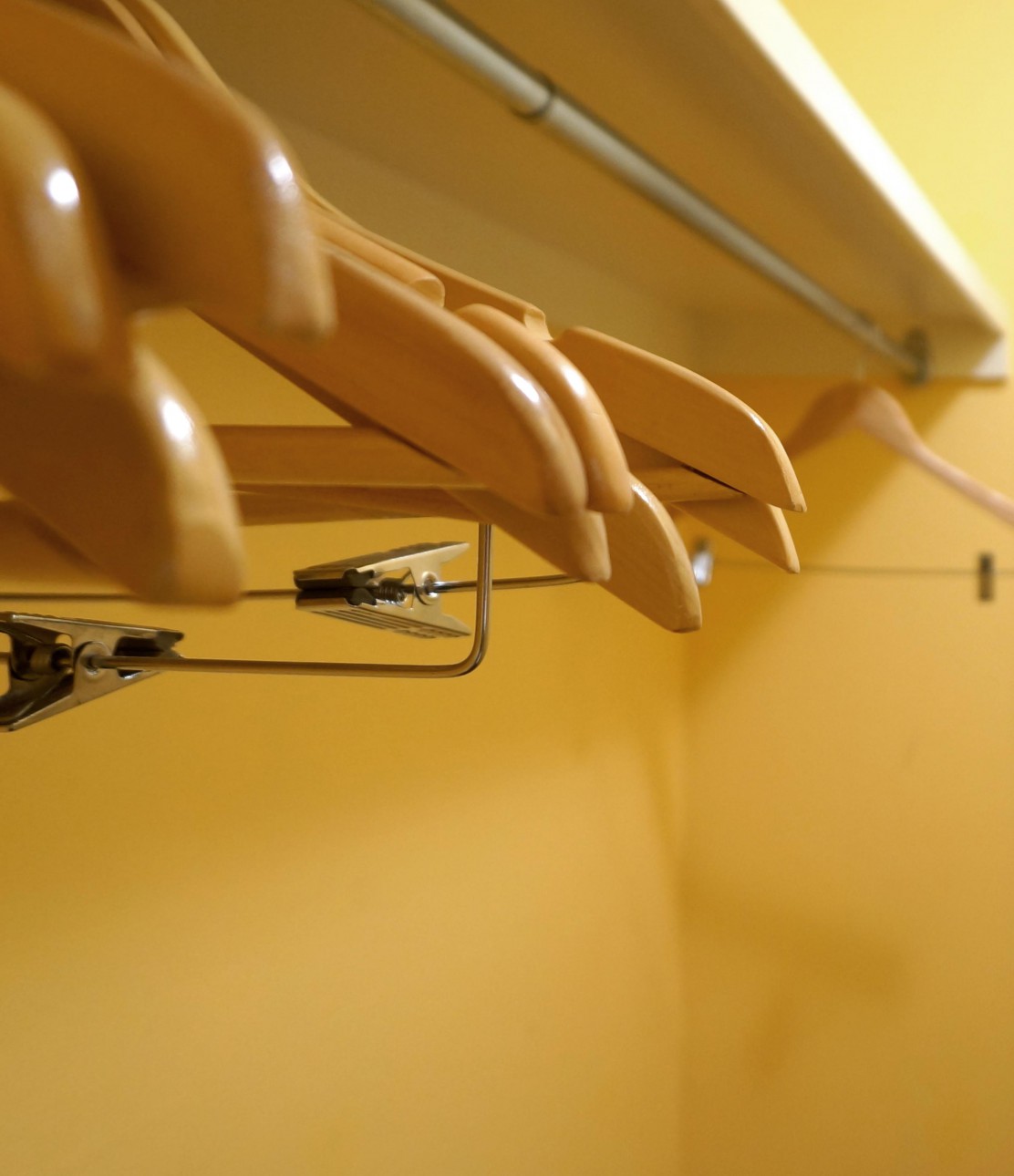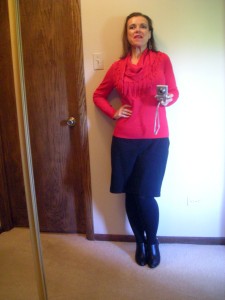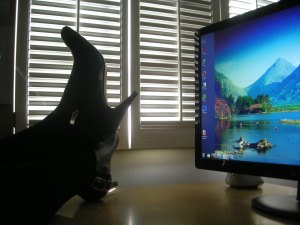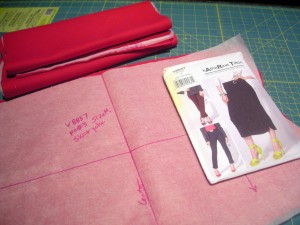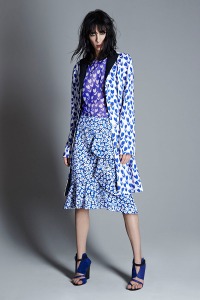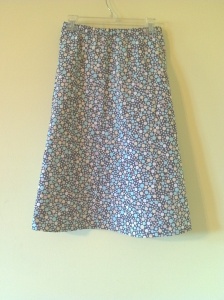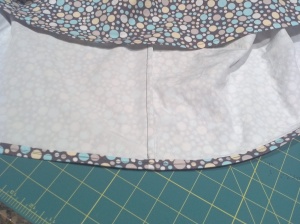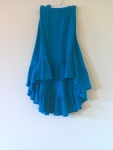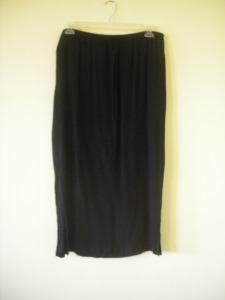The other day, when I blogged about my 90-minute skirt, I mentioned that I removed four inches from the waist in the pattern. This alteration was made before I cut the fabric, an adjustment to the pattern itself. I find paper alterations to be easy and effective. They don’t take a lot of time and they make the final fitting easier. Here’s how I did this particular adjustment.
All you need are a tape measure, paper, a drafting ruler, and a dose of self-awareness. I have several different kinds of paper I keep on hand.
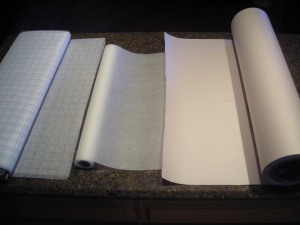
On the left is a bolt of Pellon (a brand of non-woven interfacing), available at any sewing store for around $3 a yard. I use my 40% JoAnn coupons on this stuff, buying the biggest bolt I can find so that I always have plenty. The pre-printed blue grid lines are one inch square, and that fact makes this stuff a worthy investment. It’s sheer enough to lay over the pattern tissue and trace, and if you know you’re moving thus-and-so line an inch, that inch is already marked on the Pellon. (Online sources: Amazon, fabric.com, ShopPellon.com) You can also sew this stuff, so it can double as a muslin for tricky to fit items like boned corsets. You can write on it with a Sharpie or other marking tool, but it is slightly prone to bleed-through, so mind what you have under it.
In the middle is a roll of plain paper. It’s slightly sheer, resists bleeding, and is about 18″ wide — I look for rolls in the 18-24″ width range, which seem to work best. This particular roll is from Staples, but this sort of paper is available at any office supply store. Look in the art paper area for banner rolls, but avoid Kraft paper, which is opaque. Something slightly sheer works better. I lay this paper right over the pattern tissue and trace the size I want, and then alter on paper from there.
On the right is an end roll of newspaper. A friend’s husband works in periodical publishing and he provided this, but you can often get these just by stopping into the local news office and asking. They ordinarily give away the end rolls if they have any handy. I know area school teachers who use this stuff for all sorts of classroom decorations, are projects, disposable table covers, and so on. It’s opaque, so I tend to use it to make copies of existing pattern piece — something I’ve done pretty regularly as I’ve lost weight and needed to adjust my slopers. I also use this when I decide I would like to take an existing t-shirt pattern and make it into a tunic or dress, for example — bigger alterations to existing patterns where I want to preserve the original pattern.
So, first I measure the pattern tissue at certain key points — in this case, the waistline, but I also measured hips. On most commercial patterns, the hip line will be 9″ below the waist line, so even if it is not marked, you can still estimate where the hip will be. (In my case, I measure the hip around 7-8″ below the waist because I am petite.) In this case, the hip was a good measurement for my body, but the waist was pretty big.

The smallest waist measurement for this particular skirt back piece was 9.5″. This piece is cut on the fold, as is the front piece. So, we subtract the 5/8″ at the seam allowance from the 9.5″ (9.5 – 0.625 = 8.875) and then double the answer because this piece is cut on the fold (8.875 x 2 = 17.75). The finished back piece will thus measure 17.75″ across the waist. The front piece was identical, meaning the finished waist would have measure 35.5″ wide.
Yikes.
This is where a bit of self-awareness comes in, but first we have to talk about ease. “Ease” is the word we use to describe the difference between body measurements and garment measurements. Positive ease means that the garment is larger than the body. Negative ease means that the garment is smaller than the body (often found in knitted garments). Wearing ease is the standard amount of positive ease that will make a garment fit comfortably at key measurement points, such as waist and bust — the measurements printed on the pattern envelope are places where ease is measured routinely. Then there is design ease, which is what the designer adds or subtracts to make the garment look a certain way. Cigarette pants have minimal design ease through the legs, and palazzo pants have a ton of design ease in the same place, which is why the two kinds of pants look so different. Also, woven fabrics will need more ease than knitted garments because knitted garments will stretch and move with the body in ways that woven fabrics will not.
So. I know that for me, my waist measurement is just a notch over 29″ right now. And I know that with an elastic waistband, I measure the elastic piece to have an inch of negative ease, so about 28″ once it is lapped and sewn. This is the self-awareness part — I know that anything bigger than that, in an elastic waistband, will feel droopy to me and I’ll spend the day tugging on my waistband. The waist on that pattern measures to 35.5″, and I would want to use elastic to draw in 7.5″ of that, which seemed like a lot to me. I don’t like the way a very gathered waist looks on my body — dirndls are just godawful hideous on me these days. So I knew I wanted to remove some of that excess, and I started by marking a point 1″ in on the side seams at the waist on the pattern piece. Then I used my drafting ruler to draw a new curve from that point to the hip.
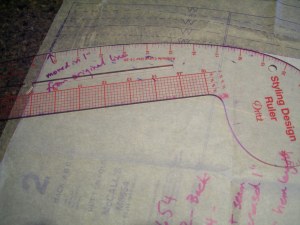
I also marked the alteration on the pattern piece, only because I know from experience that I can never remember what I did.
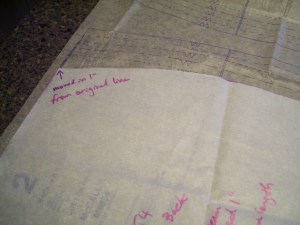
And that’s it. That 1″ adjustment on the front and back pieces removed 4″ from the waist, reducing it from 35.5″ finished to 31.5″ finished measure. I still used the 28″ waistband elastic finished measurement, so that meant the waistband was gathered slightly but not much. I also trimmed a bit off the waistband pattern piece, which was a plain rectangle with no waist shaping, so this meant simply hacking off four inches there, too, without worrying about waistband shaping.
This particular alteration is among the easiest to make, and I make it as a matter of routine on my skirt and pant waistbands.
Theresa
